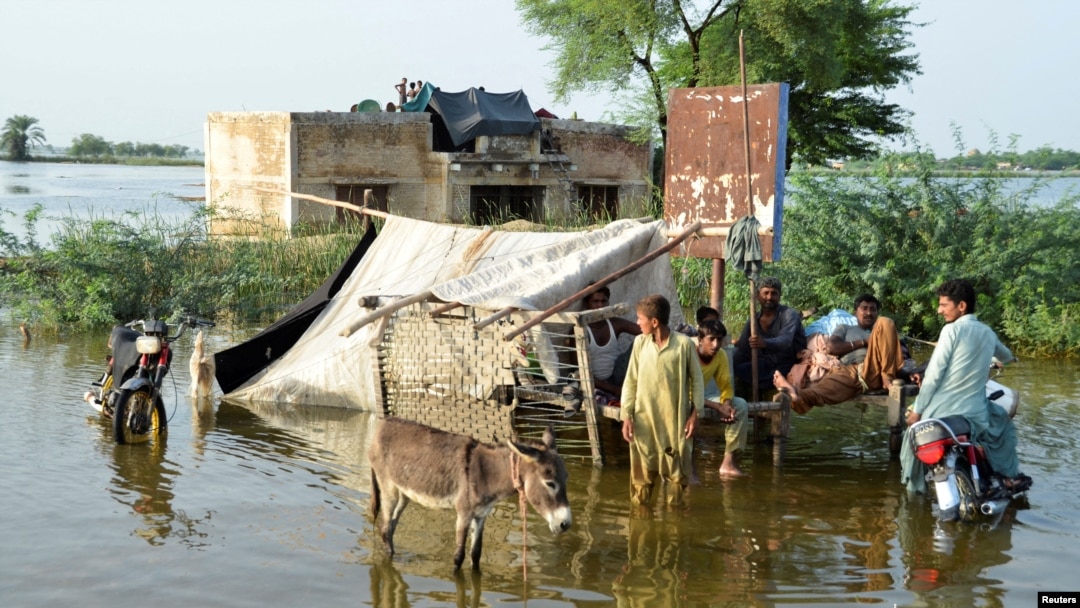The death toll from widespread flooding in Pakistan triggered by "monster monsoons" has surpassed 1,000 people and will lead to economic losses of at least $10 billion, officials in Islamabad said.
The country's National Disaster Management Authority on August 29 said 1,136 people have died since June from the flooding, but experts said some 33 million people have been affected and that the casualty totals are sure to increase.
At least 75 people have been killed in the past 24 hours, but rescue crews are still attempting to reach remote areas, authorities said.
In Sindh Province, a boat attempting to rescue survivors of the flooding capsized, leaving at least 13 people dead, officials said.
The incident occurred on August 29 in the town of Sehwan in one of the areas worst-affected by the floods.
Farid ud Din Mustafa, deputy commissioner of the Jamshoro District, where the incident happened, told reporters that the accident took place during rescue operations.
He added that seven people were saved by the rescue workers and that four others were still missing.
Meanwhile, Planning Minister Ahsan Iqbal told Reuters in an interview on August 29 that economic losses will be huge.
"So far, a very early, preliminary estimate is that it is big -- it is higher than $10 billion," Iqbal said.
He said an estimated 45 percent of cotton crops have been destroyed in addition to massive damage to vegetable, fruit, and rice fields.
Your browser doesn’t support HTML5
Relentless Rain Threatens Key Infrastructure In Pakistan
He added that nearly 1 million homes have been damaged and that it could take five years for the nation to recover.
International aid has begun to reach Pakistan amid the widespread flooding.
Cargo planes from Turkey and the United Arab Emirates (U.A.E.) landed on August 28, bringing tents, food, and other needed material.
The U.A.E. Embassy in Pakistan wrote on Twitter that a plane had landed in Rawalpindi loaded with aid, including tents, medical supplies, and food delivered to Pakistani authorities.
Trucks carrying tents, food, and water arranged by Pakistan were also being dispatched to various parts of the country by the National Disaster Management Authority for tens of thousands of flood victims.
Prime Minister Shabaz Sharif on August 29 said the rains are the heaviest Pakistan has seen in three decades.
"I saw floodwater everywhere, wherever I went in recent days and even today," Sharif said in Charsadda, one of the impacted towns. He said the planes carrying aid from some countries have already reached Pakistan, and he predicted more.
Bilal Faizi, spokesman for the Khyber Pakhtunkhwa Rescue Agency, told Radio Mashaal on August 28 that about 80,000 people had been displaced in Peshawar, Nawshar, and Charsadda.
Sharif has said the government would provide housing to all those who lost their homes.
Pakistani authorities say this year's devastation is worse than in 2010, when floods killed 1,700 people. General Qamar Javed Bajwa, the country's military chief, said on August 28 that his country may take years to recover. He appealed to Pakistanis living abroad to generously donate to the flood victims.
Sherry Rehman, Pakistan's climate minister, has described the unusual rainfall as a "monster monsoon."
She said Pakistan suffered heavier rains this year mainly because of climate change, which also caused fire in forests.
Authorities say they were using military planes, helicopters, trucks, and boats to evacuate marooned people and deliver much-need aid to them.
Miftah said Pakistan will consider importing vegetables from neighbor and bitter rival India to help flood survivors amid surging prices for food.
"We can consider importing vegetables from India," he told local Geo News TV, adding that Iran and Turkey could also be options for obtaining emergency supplies.


